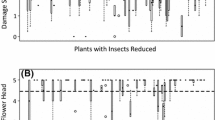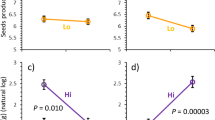Abstract
Herbivores may damage both leaves and reproductive structures, and although such combined damage may affect plant fitness non-additively, this has received little attention. We conducted a 2-year field experiment with a factorial design to examine the effects of simulated leaf (0, 12.5, 25, or 50% of leaf area removed) and inflorescence damage (0 vs. 50% of inflorescences removed) on survival, growth and reproduction in the perennial herb Arabidopsis lyrata. Leaf and inflorescence damage negatively and independently reduced flower, fruit and seed production in the year of damage; leaf damage also reduced rosette size by the end of the first season and flower production in the second year. Leaf damage alone reduced the proportion of flowers forming a fruit and fruit production per plant the second year, but when combined with inflorescence damage no such effect was observed (significant leaf × inflorescence damage interaction). Damage to leaves (sources) caused a greater reduction in future reproduction than did simultaneous damage to leaves and inflorescences (sinks). This demonstrates that a full understanding of the effects of herbivore damage on plant fitness requires that consequences of damage to vegetative and reproductive structures are evaluated over more than 1 year and that non-additive effects are considered.


Similar content being viewed by others

References
Ackerman JD, Montalvo AM (1990) Short- and long-term limitations to fruit production in a tropical orchid. Ecology 71:263–272
Belsky AJ (1986) Does herbivory benefit plants? a review of the evidence. Am Nat 127:870–892
Bergelson J, Juenger T, Crawley MJ (1996) Regrowth following herbivory in Ipomopsis aggregata: compensation but not overcompensation. Am Nat 148:744–755
Boege K, Marquis RJ (2005) Facing herbivory as you grow up: the ontogeny of resistance in plants. Trends Ecol Evol 20:441–448
Cardel YJ, Koptur S (2010) Effects of florivory on the pollination of flowers: an experimental field study with a perennial plant. Int J Plant Sci 171:283–292
Clauss MJ, Koch MA (2006) Poorly known relatives of Arabidopsis thaliana. Trends Plant Sci 11:449–459
Crawley MJ (1989) Insect herbivores and plant population dynamics. Annu Rev Entomol 34:531–564
Crawley MJ (2007) The R book. Wiley, Chichester
Danckwerts JE (1993) Reserve carbon and photosynthesis—their role in regrowth of Themeda triandra, a widely distributed subtropical graminaceous species. Funct Ecol 7:634–641
Delaney KJ, Higley LG (2006) An insect countermeasure impacts plant physiology: midrib vein cutting, defoliation and leaf photosynthesis. Plant Cell Environ 29:1245–1258
Fang X, Yuan J, Wang G, Zhao Z (2005) Fruit production of shrub, Caragana korshinskii, following above-ground partial shoot removal: mechanisms underlying compensation. Plant Ecol 187:213–225
Garcia MB, Ehrlén J (2002) Reproductive effort and herbivory timing in a perennial herb: fitness components at the individual and population levels. Am J Bot 89:1295–1302
Garrish RS, Lee TD (1989) Physiological integration in Cassia fasciculata Michx.: inflorescence removal and defoliation experiments. Oecologia 81:279–284
Gaudeul M, Stenøien H, Ågren J (2007) Landscape structure, clonal propagation, and genetic diversity in Scandinavian populations of Arabidopsis lyrata (Brassicaceae). Am J Bot 94:1146–1155
Haukioja E, Koricheva J (2000) Tolerance to herbivory in woody vs. herbaceous plants. Evol Ecol 14:551–562
Hendrix SD (1988) Herbivory and its impact on plant reproduction. In: Lovett Doust J, Lovett Doust L (eds) Plant reproductive ecology. Oxford University Press, New York, pp 246–263
Hjältén J (2004) Simulating herbivory: problems and possibilities. Ecol Stud 173:243–255
Huhta AP, Rautio P, Hellström K, Saari M, Tuomi J (2009) Tolerance of a perennial herb, Pimpinella saxifraga, to simulated flower herbivory and grazing: immediate repair of injury or postponed reproduction? Plant Ecol 201:599–609
Irwin RE, Brody AK (2011) Additive effects of herbivory, nectar robbing and seed predation on male and female fitness estimates of the host plant Ipomopsis aggregata. Oecologia 166:681–692
Karban R, Strauss SY (1993) Effects of herbivores on growth and reproduction of their perennial host, Erigeron glaucus. Ecology 74:39–46
Kärkkäinen K, Ågren J (2002) Genetic basis of trichome production in Arabidopsis lyrata. Hereditas 136:219–226
Kärkkäinen K, Kuittinen H, van Treuren R, Vogl C, Oikarinen S, Savolainen O (1999) Genetic basis of inbreeding depression in Arabis petraea. Evolution 53:1354–1365
Kärkkäinen K, Løe G, Ågren J (2004) Population structure in Arabidopsis lyrata: evidence for divergent selection on trichome production. Evolution 58:2831–2836
Kelly CA, Dyer RJ (2002) Demographic consequences of inflorescence-feeding insects for Liatris cylindracea, an iteroparous perennial. Oecologia 132:350–360
Krupnick GA, Weis AE (1999) The effect of floral herbivory on male and female reproductive success in Isomeris arborea. Ecology 80:135–1149
Krupnick GA, Weis AE, Campbell DR (1999) The consequences of floral herbivory for pollinator service to Isomeris arborea. Ecology 80:125–134
Leavitt H, Robertson IC (2006) Petal herbivory by chrysomelid beetles (Phyllotreta sp.) is detrimental to pollination and seed production in Lepidium papilliferum (Brassicaceae). Ecol Entomol 31:657–660
Lehtilä K, Boalt E (2004) The use and usefulness of artificial herbivory in plant-herbivore studies. Ecol Stud 173:257–265
Løe G (2006) Ecology and evolution of resistance to herbivory: Trichome production in Arabidopsis lyrata. PhD dissertation, Uppsala University
Løe G, Toräng P, Gaudeul M, Ågren J (2007) Trichome production and spatiotemporal variation in herbivory in the perennial herb Arabidopsis lyrata. Oikos 116:134–142
Louda SM, Potvin MA (1995) Effect of inflorescence-feeding insects on the demography and lifetime fitness of a native plant. Ecology 76:229–245
Mabry CM, Wayne PW (1997) Defoliation of the annual herb Abutilon theophrasti: mechanism underling reproductive compensation. Oecologia 111:225–232
Maron JL, Crone E (2006) Herbivory: effects on plant abundance, distribution and population growth. Proc R Soc Lond B 273:2575–2584
Marquis RJ (1984) Leaf herbivores decrease fitness of a tropical plant. Science 226:537–539
Marquis RJ (1992) The selective impact of herbivores. In: Fritz RS, Simms EL (eds) Plant resistance to herbivores and pathogens. University of Chicago Press, Chicago, pp 301–325
McCall AC (2007) Leaf damage and gender but not flower damage affect female fitness in Nemophila menziessi. Am J Bot 94:445–450
McCall AC, Irwin RE (2006) Florivory: the intersection of pollination and herbivory. Ecol Lett 9:1351–1365
Mendoza A, Piñero D, Sarukhán J (1987) Effects of experimental defoliation on growth, reproduction and survival of Astrocaryum mexicanum. J Ecol 75:545–554
Mothershead K, Marquis RJ (2000) Fitness impacts of herbivory through indirect effects on plant–pollinator interactions in Oenothera macrocarpa. Ecology 81:30–40
O’Kane SL, Al’Shehbaz IA (1997) A synopsis of Arabidopsis (Brassicaceae). Novon 7:323–327
Obeso JR (1993) Does defoliation affect reproductive output in herbaceous perennials and woody plants in different ways? Funct Ecol 7:150–155
Parra-Tabla V, Rico-Gray V, Carbajal M (2004) Effect of defoliation on leaf growth, sexual expression and reproductive success of Cnidoscolus aconitifolius (Euphorbiaceae). Plant Ecol 173:153–160
Pellegrino G, Musacchio A (2006) Effects of defoliation on reproductive success in two orchids, Serapias vomeracea and Dactylorhiza sambucina. Ann Bot Fennici 43:123–128
Pilson D, Decker KL (2002) Compensation for herbivory in wild sunflower: response to simulated damage by the head-clipping weevil. Ecology 83:3097–3107
Primack RB, Hall P (1990) Cost of reproduction in the pink lady’s slipper orchid: a four-year experimental study. Am Nat 136:638–656
Primack RB, Miao SL, Becker KR (1994) Costs of reproduction in the pink lady’s slipper orchid (Cypripedium acaule): defoliation, increased fruit production and fire. Am J Bot 81:1083–1090
R Development Core Team (2008) R: a language and environment for statistical computing. R Foundation for Statistical Computing, Vienna
Rebek KA, O’Neil RJ (2005) The effects of natural and manipulated density regimes on Alliaria petiolata survival, growth and reproduction. Weed Res 46:345–352
Retuerto R, Fernández-Lema B, Obeso JR (2006) Changes in photochemical efficiency in responses to herbivory and experimental defoliation in the dioecious tree Ilex aquifolium. Int J Plant Sci 167:279–289
Rodríguez-Rodríguez MC, Valido A (2011) Consequences of plant-pollinator and floral-herbivore interactions on the reproductive success of the Canary Islands endemic Canarina canariensis (Campanulaceae). Am J Bot 98:1465–1474
Rose KE, Louda SM, Rees M (2005) Demographic and evolutionary impacts of native and invasive insect herbivores on Cirsium canescens. Ecology 86:453–465
Sandring S, Ågren J (2009) Pollinator-mediated selection on floral display and flowering time in the perennial herb Arabidopsis lyrata. Evolution 63:1292–1300
Schwachtje J, Baldwin IT (2008) Why does herbivore attack reconfigure primary metabolism? Plant Physiol 146:845–851
Spotswood E, Bradley KL, Knops JMH (2002) Effects of herbivory on the reproductive effort of 4 prairie perennials. BMC Ecol 2:2
Stowe KA, Marquis RJ, Hochwender CG, Simms EL (2000) The evolutionary ecology of tolerance to consumer damage. Annu Rev Ecol Syst 31:565–595
Strauss SY (1991) Direct, indirect and cumulative effects of three native herbivores on a shared host plant. Ecology 72:543–558
Strauss SY, Agrawal AA (1999) The ecology and evolution of plant tolerance to herbivory. Trends Ecol Evol 14:179–185
Trumble JT, Kolodny-Hirsch DM, Ting IP (1993) Plant compensation for arthropod herbivory. Annu Rev Entomol 38:93–119
Vallius E, Salonen V (2000) Effects of defoliation on male and female reproductive traits of a perennial orchid, Dactylorhiza maculata. Funct Ecol 14:668–674
Venables WN, Ripley BD (2002) Modern applied statistics with S, 4th edn. Springer, New York
Venecz JI, Aarssen LW (1998) Effects of shoot apex removal in Lythrum salicaria (Lythraceae): assessing the costs of reproduction and apical dominance. Ann Bot Fenn 35:101–111
Wallace DD, O’Dowd DJ (1989) The effect of nutrients and inflorescence damage by insects on fruit-set by Banksia spinulosa. Oecologia 79:482–488
Wise MJ, Abrahamson WG (2007) Effects of resource availability on tolerance of herbivory: a review and assessment of three opposing models. Am Nat 169:443–454
Wise MJ, Cummins JJ (2006) Strategies of Solanum carolinense for regulating maternal investment in response to foliar and floral herbivory. J Ecol 94:629–636
Wise MJ, Cummins JJ, De Young C (2008) Compensation for floral herbivory in Solanum carolinense: identifying mechanisms of tolerance. Evol Ecol 22:19–37
Acknowledgments
We thank Richard Karban and Mikaela Huntzinger for helpful comments on earlier versions of the manuscript, and Julia Koricheva and two anonymous reviewers for valuable comments on the latest version. The study was financially supported by grants from the Helge Axelssons Johnsons Stiftelse, Tullbergs Stiftelse and Bertil Lundmans Fund to A.P. and from Formas and the Swedish Research Council to J.Å.
Author information
Authors and Affiliations
Corresponding author
Additional information
Communicated by Julia Koricheva.
Rights and permissions
About this article
Cite this article
Puentes, A., Ågren, J. Additive and non-additive effects of simulated leaf and inflorescence damage on survival, growth and reproduction of the perennial herb Arabidopsis lyrata . Oecologia 169, 1033–1042 (2012). https://doi.org/10.1007/s00442-012-2276-1
Received:
Accepted:
Published:
Issue Date:
DOI: https://doi.org/10.1007/s00442-012-2276-1



